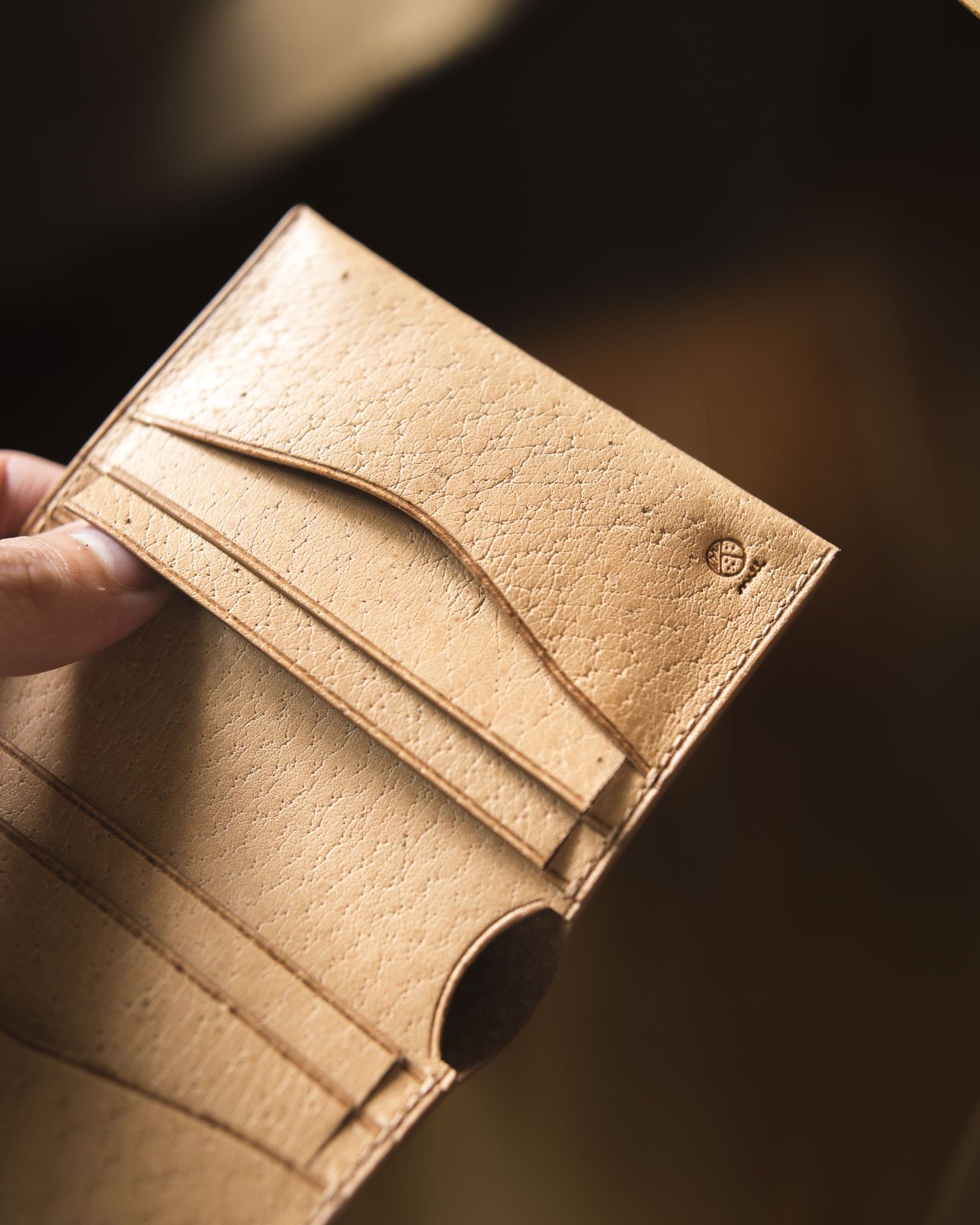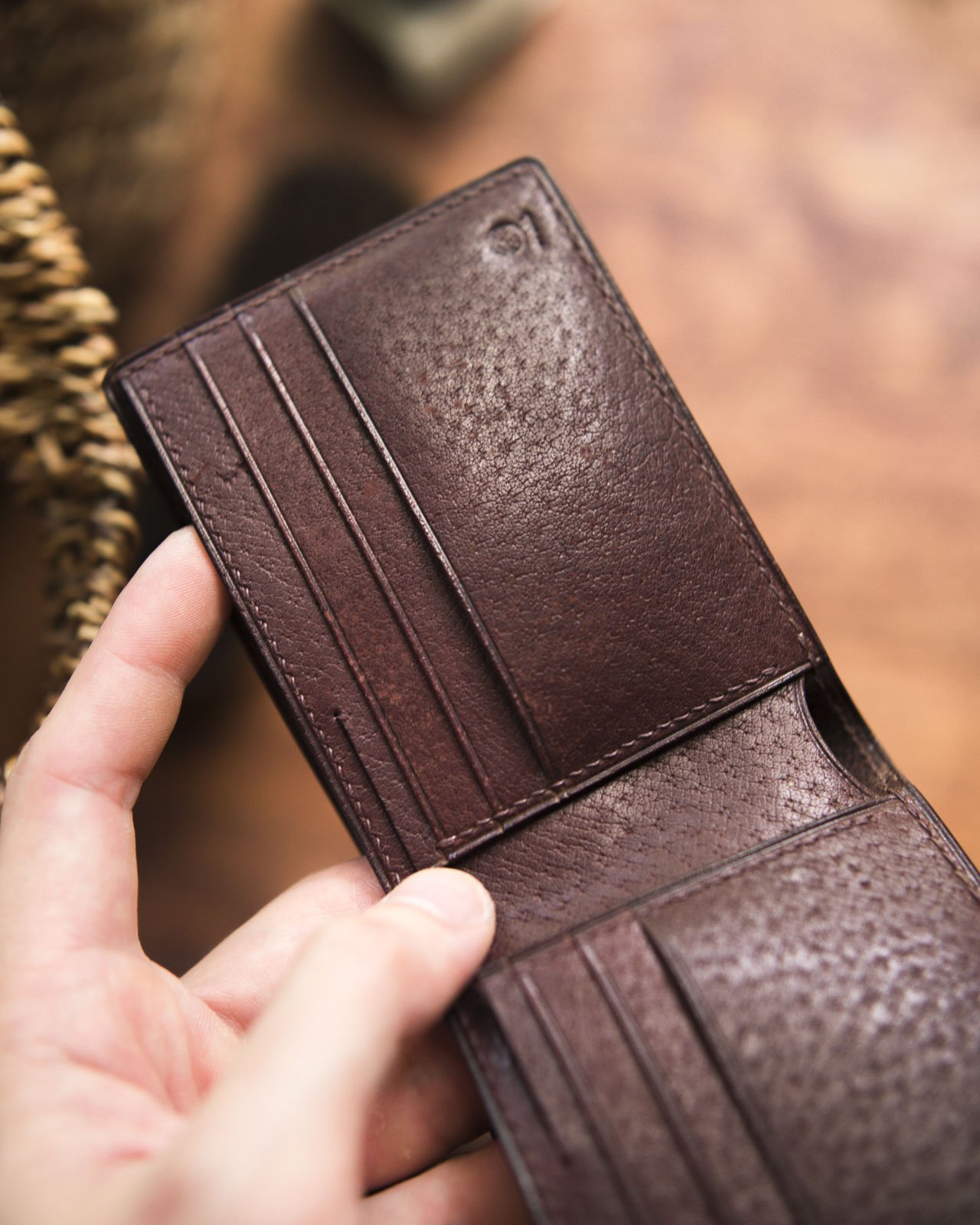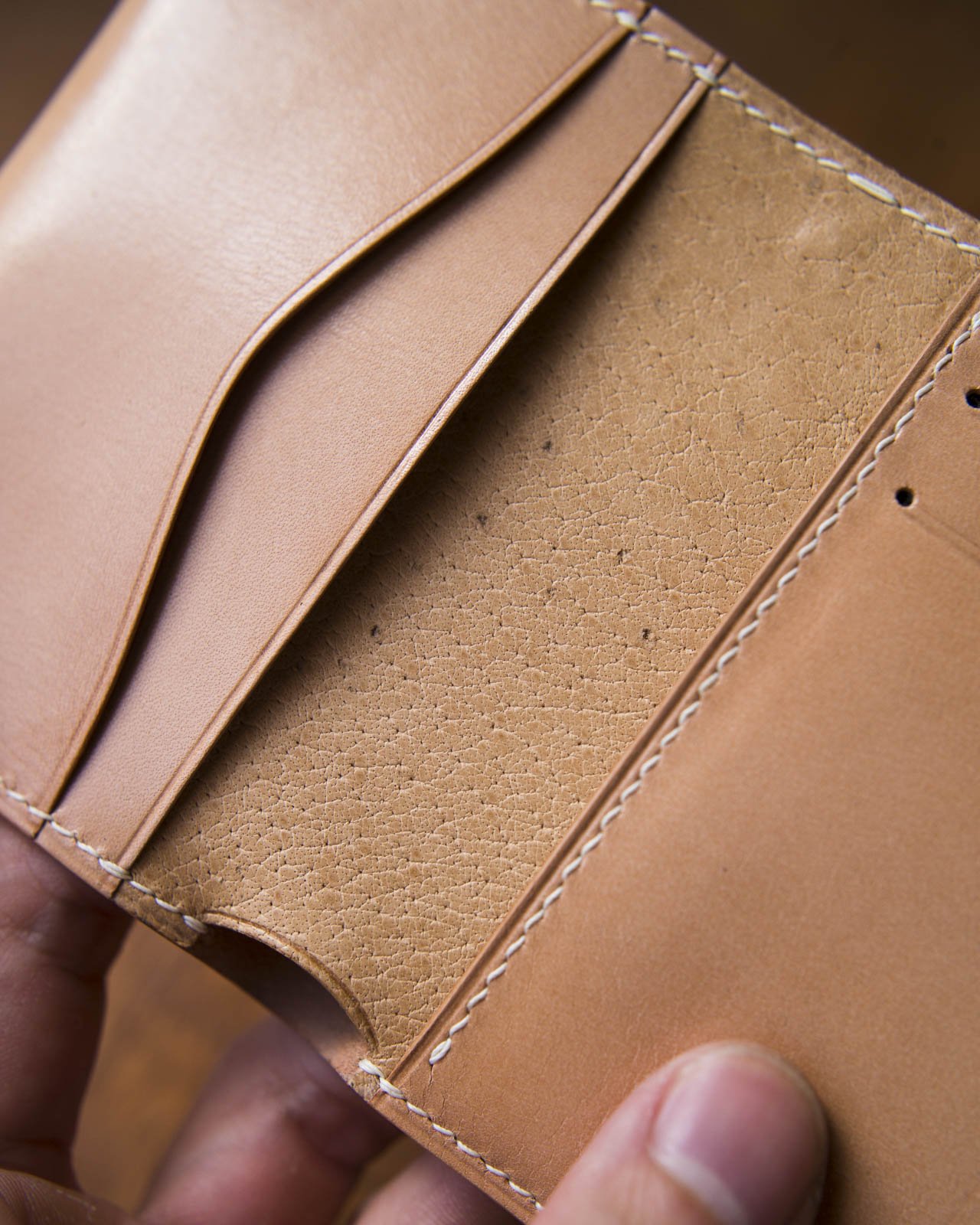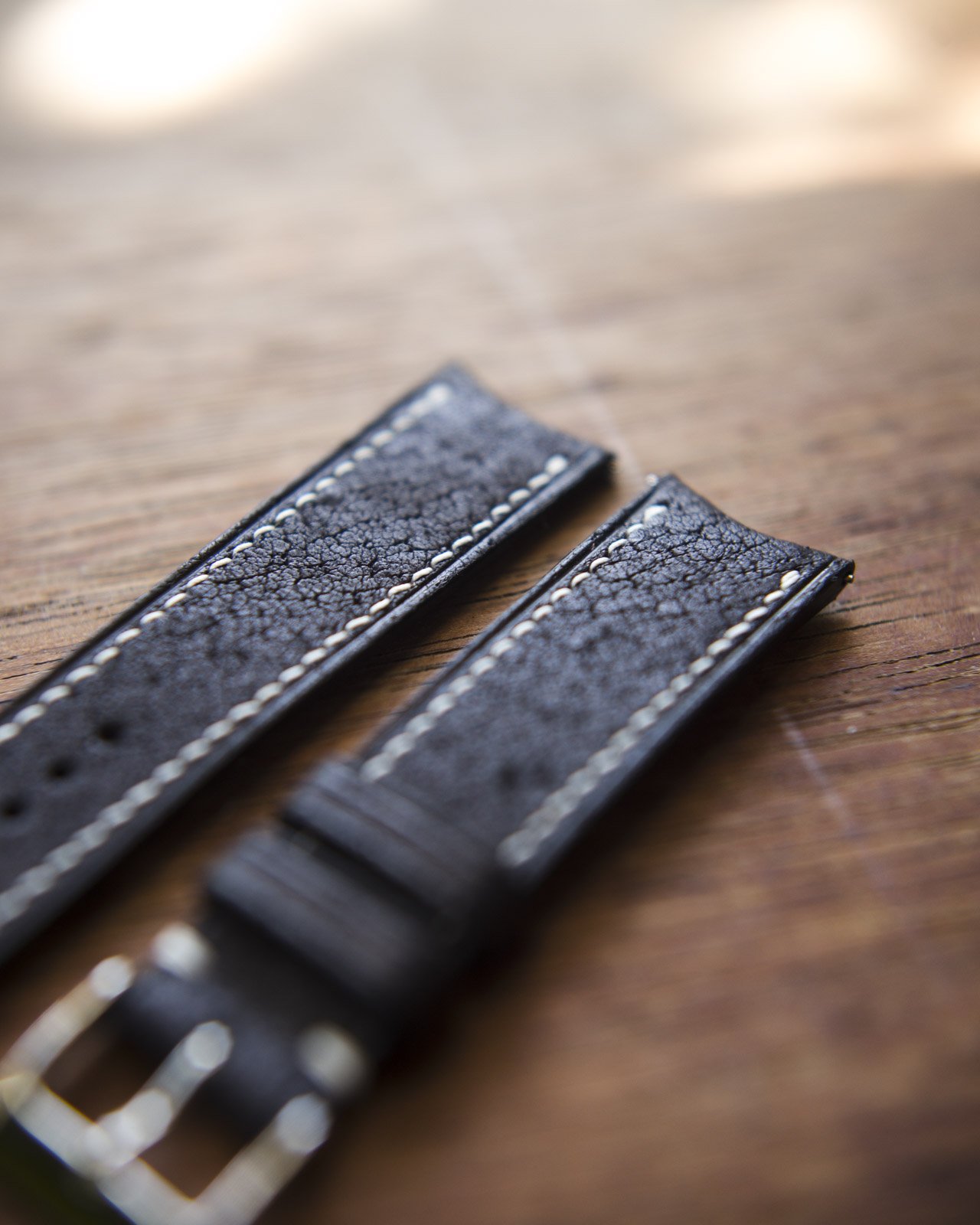Japanese wild boar
One of the strongest types of leather available, pigskins are typically chrome tanned in thin weights to be used for lining in footwear. The Japanese wild boar is a byproduct of farmland protection, sourced locally by hunters and farmers. Unlike the more common pigskin these hides are full vegetable tanned and prepped in thicker weights. The hides have a medium yet structured temper making them suitable to use for small goods.
Due to its exposure to nature the skins are going to be imperfect with natural scarring and marks. Boar hides are characterized by a unique follicle grain and is renowned for its excellent resistance to abrasions and wear.
For more information of the history of jibie (wild game) leather an interview with Taka is available below.
Wild boar colour swatch.
Tannery: Almighty tannery (Himeji).
Temper: Medium.
Surface: Supple texture with a unique follicle grain pattern.
Tanning: Vegetable tanned.
Patina: Heavy.
Other notes: One of the strongest types of leather available. Has excellent resistance to abrasion, use and tear.
Product samples and gallery




Wild boar detail.
Drum tanning process.
Natural boar details.
Flesh side showing follicle pigments.
Black boar details.
Translated Interview
Taka,
Thank you for taking the time to take the interview. Over the many years of crafting I've seen a various trends of leathers in the market and recently I'm very interested in finding leathers from a more naturally sourced environment. The wild boar leather has really caught my eye and I hope you could share some details in regards to its history.
1. Could you share some info about the tannery history?
First of all, deerskin is tanned by Maruta Sangyo a tanner in Tatsuno City, Hyogo Prefecture. http://maruta-ind.com/ Founded in 1977 Maruta Sangyo is relatively new but it has a long history. I have been tanning for a long time in Tatsuno City including my relatives. We specialize in softening and coloring leather and we are very good at making soft leather that goes well with deerskin.Next, boar leather and bear leather are manufactured by "Almighty" in Himeji City Hyogo Prefecture. http://almighty-ame.jp/According to an old book Himeji was a tanning production area around 200 AD. According to official records, tanning is done in Himeji City which has an old townscape that has been tanning since around 1000 AD.The water and climate of Himeji City is well-known as a place suitable for tanning making it one of the best tanning areas in Japan. The tanning style of Almighty is based on traditional tanning method, using the highest quality hides that pursues the quality, texture, and durability of the leather.2. I read that wild boars have encroached agriculture so that farmers have to take action to protect the crops. Are they mainly sourced by farmers or hunters?
It must have been captured by hunting. To hunt in Japan you need a "hunting license". There are also people who work as farmers and hunters as a side business. There are almost no people who live as hunters alone so in the current situation most people are hunters while working side jobs.3. I've also noticed that jibie meat is starting to be on the menu of some prominent restaurants. Are wild boars utilised in full for their meat and leather?
Although it is a nationwide scale, unfortunately the utilization rate in terms of the number of catches is less than 10%. There are two main reasons. The first is that it is difficult to sell meat in Japan. This is because the use of meat is subject to strict screening and inspection in Japan, making it difficult for general hunters to sell it.The current situation is that the use of meat is largely dependent on game processing plants.https://the-natural-wild.jp/The second is age. Currently most hunters in Japan are over the age of 65 and the number of young hunters are decreasing. Because there are no young hunters the current situation is that there is no power to carry deer and boars from the mountains.4. Could you share some insights on the production process? From hunting to collection of skins and production of leather.
Captured by hunters → stripped at the game processing plant → collected VARIED → requested tanning to tanners → after the leather is completed, returned to VARIED → sold to public.5. What are some unique characteristics of wild boar leather?
Strong wear resistance/durability. Boar leather is a wild game leather so it will inevitably have natural scratches (proof of living in the wild), but a little rubbing or scratching is totally fine!
Japanese boar leather has a much denser leather fiber than similar pig/peccary/chingiare leather. This leather fiber comes to life when it is utilized in goods, making it a product that is resistant to scratches and deformation. More water resistant than other leathers. The fact that the leather fibers are dense means that there are fewer holes for moisture to enter.
Also, even if moisture gets into the leather fibers the wrinkles/pores unique to boar leather evaporate the moisture making it less likely to cause water marks or wrinkles than other leathers.Here is a word that is often said: as for durability the boar's skin is so strong that it can't be defeated with a shotgun.6. I read you also produce other types of leather like deer and potentially bear? Will these be available for overseas export?
The Japanese government does not have any regulations regarding wild boars and deer but regarding bear skins it is not possible to sell them overseas because they are stipulated in the Washington Convention.Original interview
こんにちは、タカさん、
今回、たかさんが扱っている皮製品について質問があり連絡させていただきました。
長年レザー製品を作っていく中で様々な革のトレンドを見てきたのですが、最近より環境を汚さない方法で製造された皮についてもっと知りたいと思うようになり、その中でも特に興味深いのがイノシシの革でした。
そこでいくつか質問させてください。
1. もし差し支えなければ、一例でも良いのでタカさんとお取引がある皮なめし工場について少し教えていただけますか?
例えば、工場の歴史や、名前の由来、その技術またはその土地ならではの特性などあれば教えていただけると嬉しいです。
まず鹿革からですが兵庫県たつの市のタンナー「丸太産業」で鞣しを行っております
1977年創業と比較的新しいタンナー様ですが、古くから歴史あるタンナーの町。たつの市でご親族を含めて長く鞣しをやられております。
得意分野は革を柔らかくすること・色を付けることを得意としており鹿革との相性がかなり良い柔らかい革を作ることに非常に得意としております。
次に猪革と熊革 こちらは兵庫県姫路市にある「オールマイティー」様で製造を行っております。
古い本によると西暦200年頃には鞣しの産地となっていた姫路市
正式な記録では西暦1000年頃から鞣しを行っている古い町並みのある姫路市で鞣しを行っております。
姫路市の水・気候は鞣しに合う場所としても有名で、日本でも屈指の鞣し場となっております。
こちらオールマイティーの鞣し方は伝統的な鞣し方をされており、
革の質・肌ざわり・丈夫さを追求した最高級の革となっております。
2.日本ではイノシシが農地を荒らすので、農作物を守るために農家の方々がイノシシを屠殺していると聞いたのですが、イノシシの皮は主に農家の方々によって殺されたイノシシから採られたものでしょうか、それとも猟師が狩猟したイノシシから採られたものでしょうか。
狩猟で捕獲されたものとなります。日本で狩猟をするには「狩猟免許」というものが必要です。
本業は農家・副業で猟師をやるかたもいらっしゃいます。
猟師だけで生活する人はほぼいないため現状では兼業をしつつ猟師をする方がほとんどです。
3.著名なレストランのメニューにジビエ肉が載っているところがあると聞いたのですが、イノシシの肉と皮は無駄なく隅々まで使われていますでしょうか?
全国規模ですが、残念ながら捕獲数における利用率は10%を切っております。
理由は大きくわけて2つございます。
1つ目は肉の販売が日本では難しいこと。
これは食肉利用について日本では厳しい審査と検査があり一般の猟師が販売するには難しいためです
食肉利用をされているのはジビエ処理場などに大きく依存しているのが現状です
2つ目は高齢化です。
現在日本の猟師は65歳以上の方が多く占められており、若い猟師が少なくなってきています。
若い猟師がいないため山から鹿や猪を運ぶ力がなくなっているのが現状です。
4.皮の生産プロセスに関して質問です。狩猟・屠殺から、レザーの生産に至るまでのプロセスを教えていただけますか?
猟師が捕獲→ジビエ処理場で皮を剥ぎ→VARIED回収→タンナー様へ鞣し依頼→leather完成後VARIEDへ戻し→皆様へ販売
5.イノシシ革特有の特徴は何でしょうか?
摩耗性/耐久性に強い
そのままですが、どの革素材と比べても圧倒的に傷がつきません。
猪革は野生革(ジビエレザー)ですので、天然の傷(野生で生きた証)はどうしても入ってしまいますが、ちょっとの擦れやひっかきは全然大丈夫です‼
日本産猪革は、類似している豚/ペッカリー/チンギアーレ革と比べ、革繊維がとても密になっています。
この革繊維が、製品に生まれ変わらせた時に活きて、傷や型崩れに強い製品にしてくれるのです。
他の革に比べ、耐水性が強い
革繊維が密になっているという事はその分、水分が入り込む穴が少ない事を意味します。
また、革繊維内に水分が入り込んでしまっても、猪革特有のシボ(皺/毛穴)が水分を揮発させる為、ほかの革より水跡やよれが起こりにくくなるそうです。
こちらがよく言われている言葉です。
耐久性についてですが散弾銃のためでは猪は倒せないほど皮が強いです。
6.鹿やクマなどの他の種類の革も生産していると拝読しました。それらの海外輸出は可能でしょうか?
猪と鹿に関しては特に日本政府から規定を定めておられませんが、熊革に関してはワシントン条約に規定があるため海外に向けての販売は不可能です。
お手数をおかけしますが、解る範囲内で結構ですのでご協力いただけたら幸いです。
お返事お待ちしてます。


